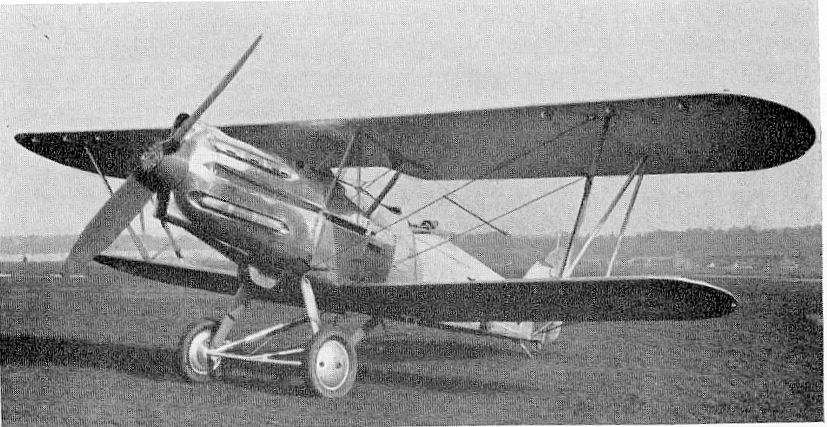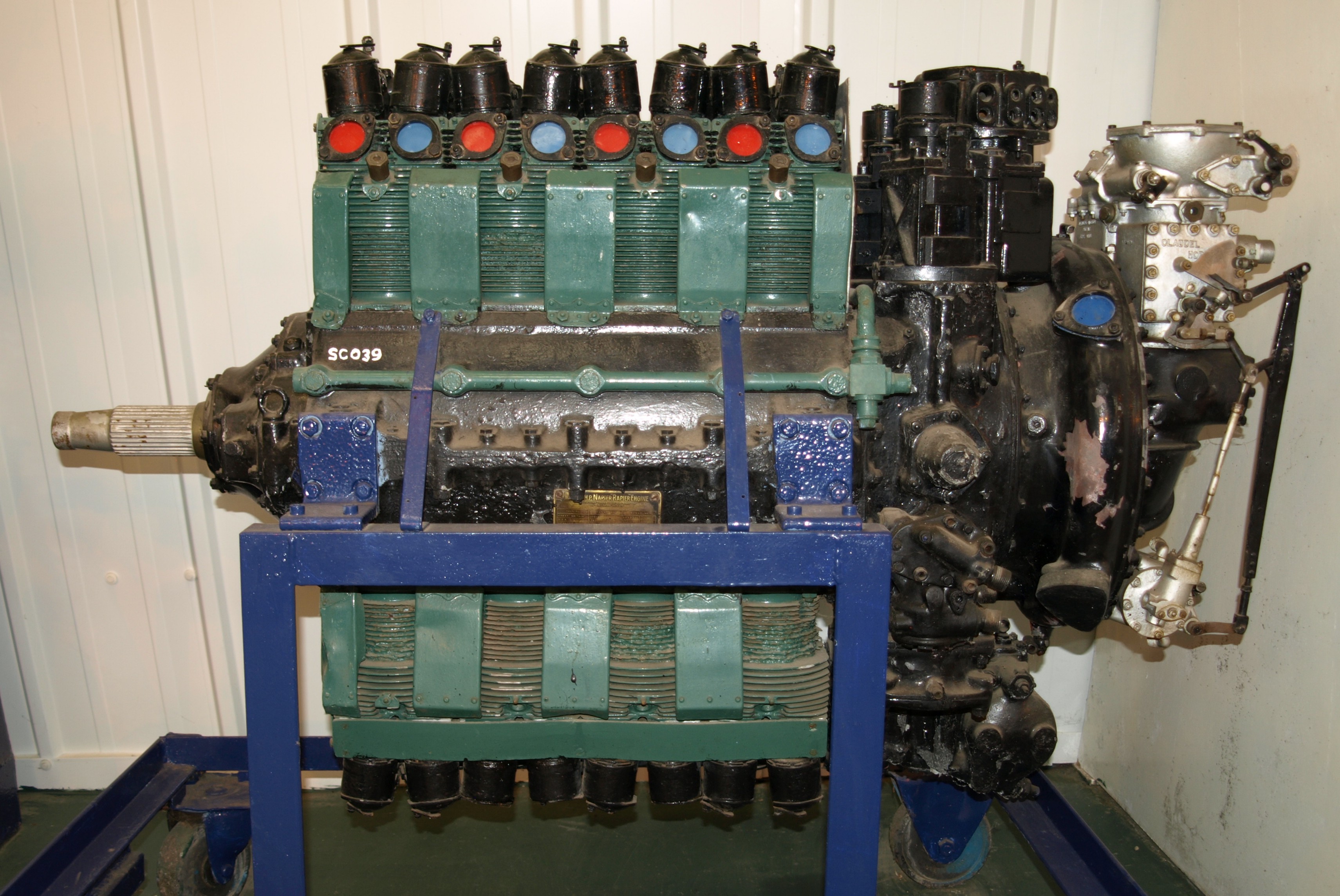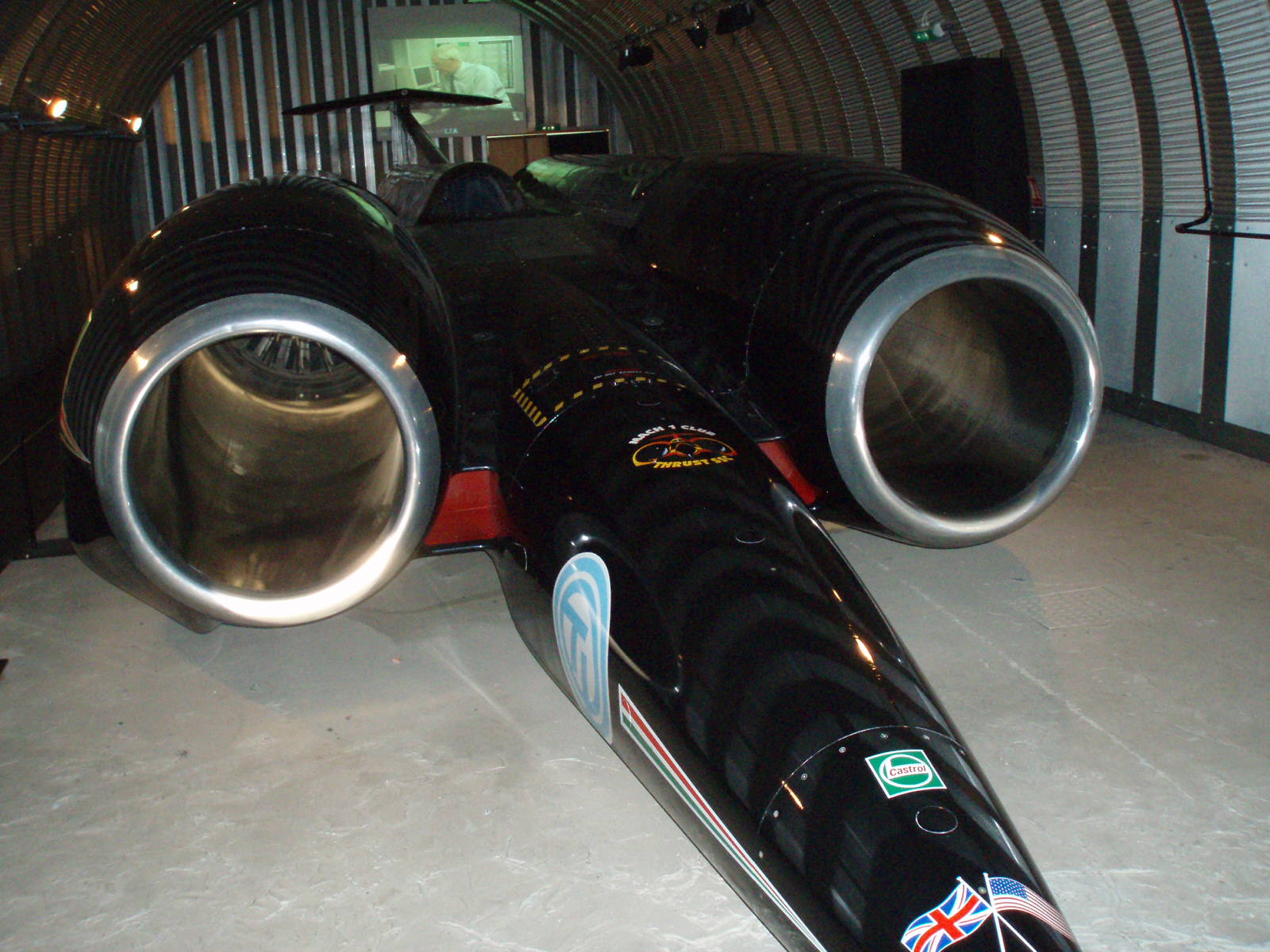|
Napier Sabre
The Napier Sabre is a British H-24-cylinder, liquid-cooled, sleeve valve, piston aero engine, designed by Major Frank Halford and built by D. Napier & Son during World War II. The engine evolved to become one of the most powerful inline piston aircraft engines in the world, developing from in its earlier versions to in late-model prototypes. The first operational aircraft to be powered by the Sabre were the Hawker Typhoon and Hawker Tempest; the first aircraft powered by the Sabre was the Napier-Heston Racer, which was designed to capture the world speed record. Other aircraft using the Sabre were early prototype and production variants of the Blackburn Firebrand, the Martin-Baker MB 3 prototype and a Hawker Fury prototype. The rapid introduction of jet engines after the war led to the quick demise of the Sabre, as there was less need for high power military piston aero engines and because Napier turned its attention to developing turboprop engines such as the Naiad and ... [...More Info...] [...Related Items...] OR: [Wikipedia] [Google] [Baidu] |
WikiProject Aircraft
A WikiProject, or Wikiproject, is a Wikimedia movement affinity group for contributors with shared goals. WikiProjects are prevalent within the largest wiki, Wikipedia, and exist to varying degrees within sister projects such as Wiktionary, Wikiquote, Wikidata, and Wikisource. They also exist in different languages, and translation of articles is a form of their collaboration. During the COVID-19 pandemic, CBS News noted the role of Wikipedia's WikiProject Medicine in maintaining the accuracy of articles related to the disease. Another WikiProject that has drawn attention is WikiProject Women Scientists, which was profiled by '' Smithsonian'' for its efforts to improve coverage of women scientists which the profile noted had "helped increase the number of female scientists on Wikipedia from around 1,600 to over 5,000". On Wikipedia Some Wikipedia WikiProjects are substantial enough to engage in cooperative activities with outside organizations relevant to the field at issue. For e ... [...More Info...] [...Related Items...] OR: [Wikipedia] [Google] [Baidu] |
Blackburn Firebrand
The Blackburn Firebrand was a British single-engine strike fighter for the Fleet Air Arm of the Royal Navy designed during World War II by Blackburn Aircraft. Originally intended to serve as a pure fighter, its unimpressive performance and the allocation of its Napier Sabre piston engine by the Ministry of Aircraft Production for the Hawker Typhoon caused it to be redesigned as a strike fighter to take advantage of its load-carrying capability. Development was slow and the first production aircraft was not delivered until after the end of the war. Only a few hundred were built before it was withdrawn from front-line service in 1953. Development In general, the Fleet Air Arm had required fighters that were capable of navigating long ranges over sea and speed differential over attackers was not critical. Defence of British naval bases was a RAF commitment but provision had not been made for this and so the Admiralty accepted that it would have to take on the duty. For this it n ... [...More Info...] [...Related Items...] OR: [Wikipedia] [Google] [Baidu] |
Napier-Heston Racer
The Napier-Heston Racer, also referred to as the Heston Type 5 Racer or Heston High Speed Aircraft J.5, Clare 1976, p. 426. was a 1940s British single-seat racing monoplane first conceived by D. Napier and Son Ltd., and built by the Heston Aircraft Company Ltd, for an attempt on the World Air Speed Record. The private venture was financed by William Morris, Lord Nuffield. Design and development The Napier-Heston Racer design team was led by Arthur Ernest Hagg of Napier & Son, and George Cornwall of Heston Aircraft Company Ltd. It was a single-engined, low-wing cantilever monoplane, purpose-built as a contender for the World Speed Record. Gunston 1976, p. 321. It was built almost entirely of wood, that served to ensure rapid construction, a "superfine" finish, and streamlined, "beautiful" lines. The use of a multi-ducted belly scoop and clear, low profile perspex canopy, along with a reputed 20 coats of hand-rubbed lacquer also contributed to the sleek aerodynamic finish. Saun ... [...More Info...] [...Related Items...] OR: [Wikipedia] [Google] [Baidu] |
Napier Dagger
The Napier Dagger was a 24-cylinder H-pattern ''(or H-Block)'' air-cooled engine designed by Frank Halford and built by Napier before World War II. It was a development of the earlier Napier Rapier. Design and development The H-Block has a compact layout, as it essentially consists of two vertically opposed, flat-twelve inline engines lying side-by-side and driving side-by-side crankshafts. Another advantage is that since the cylinders are opposed, the motion in one is balanced by the opposite motion in the one on the opposite side, leading to very smooth running. The Dagger was remarkable for its fast rotation, running at up to 4,000 rpm but unlike the later Napier Sabre, it had conventional poppet valves. Although considered a masterpiece of engine design by Frank Halford, there were problems with cooling, maintenance, manufacturing and weight, which were not solved during the Dagger's lifetime and went unresolved well into the lifetime of the Napier Sabre, its successor. ... [...More Info...] [...Related Items...] OR: [Wikipedia] [Google] [Baidu] |
Napier Rapier
The Napier Rapier was a British 16-cylinder H pattern air-cooled aero engine designed by Frank Halford and built by Napier & Son shortly before World War II. Design and development The Rapier was the first of Napier's H cylinder engines. The rationale for the H is fairly straightforward, in that rather than having an engine with fewer large cylinders, more small cylinders could simply be added. It was believed that an H pattern engine would provide substantially more power and higher RPM's for the same frontal area as a large liquid-cooled V engine. The maximum RPM in a dive was 4,800. The H-block has a compact layout, as it essentially consists of two vertically opposed inline engines lying one beside another driving side by side crankshafts. Another advantage is that since the cylinders are opposed, the motion in one is balanced by the opposite motion in the one on the opposite side, leading to very smooth running. The Rapier suffered many of the same problems as the late ... [...More Info...] [...Related Items...] OR: [Wikipedia] [Google] [Baidu] |
Land Speed Record
The land speed record (or absolute land speed record) is the highest speed achieved by a person using a vehicle on land. There is no single body for validation and regulation; in practice the Category C ("Special Vehicles") flying start regulations are used, officiated by regional or national organizations under the auspices of the Fédération Internationale de l'Automobile (FIA). The land speed record (LSR) is standardized as the speed over a course of fixed length, averaged over two runs (commonly called "passes"). Two runs are required in opposite directions within one hour, and a new record mark must exceed the previous one by at least one percent to be validated. History The first regulator was the ''Automobile Club de France'', which proclaimed itself arbiter of the record in about 1902. Until 1903, trains held the land speed record for fastest vehicles in which people could travel. Different clubs had different standards and did not always recognize the same wor ... [...More Info...] [...Related Items...] OR: [Wikipedia] [Google] [Baidu] |
Schneider Trophy
The Coupe d'Aviation Maritime Jacques Schneider, also known as the Schneider Trophy, Schneider Prize or (incorrectly) the Schneider Cup is a trophy that was awarded annually (and later, biennially) to the winner of a race for seaplanes and flying boats. The Schneider Trophy is now held at the Science Museum, South Kensington, London. Announced in 1912 by Jacques Schneider, a French financier, balloonist and aircraft enthusiast, the competition offered a prize of approximately £1,000. The race was held twelve times between 1913 and 1931. It was intended to encourage technical advances in civil aviation but became a contest for pure speed with laps over a (usually) triangular course, initially and later extended to . The contests were staged as time trials, with aircraft setting off individually at set intervals, usually 15 minutes apart. The contests were very popular and some attracted crowds of over 200,000 spectators. The race was significant in advancing aeroplane design, pa ... [...More Info...] [...Related Items...] OR: [Wikipedia] [Google] [Baidu] |
Supermarine
Supermarine was a British aircraft manufacturer that is most famous for producing the Supermarine Spitfire, Spitfire fighter plane during World War II as well as a range of seaplanes and flying boats, and a series of Jet engine, jet-powered fighter aircraft after World War II. The company had successes in the Schneider Trophy for seaplanes, with three wins in a row of 1927, 1929 and 1931. The company was founded in 1913 as Pemberton-Billing Ltd on the River Itchen, Hampshire, River Itchen close to Woolston, Southampton, on ground previously purchased by Noel Pemberton Billing to construct motor launches. It produced a couple of prototypes using quadruplane designs to shoot down zeppelins, the Supermarine P.B.29 and the Supermarine Nighthawk. The aircraft were fitted with the recoilless rifle, recoilless Davis gun and the Nighthawk had a separate powerplant to power a searchlight.The World's Worst Aircraft James Gilbert Upon election as a Member of Parliament (United Kingdom), M ... [...More Info...] [...Related Items...] OR: [Wikipedia] [Google] [Baidu] |
Napier Lion
The Napier Lion is a 12-cylinder, petrol-fueled 'broad arrow' W12 configuration aircraft engine built by D. Napier & Son from 1917 until the 1930s. A number of advanced features made it the most powerful engine of its day and kept it in production long after other contemporary designs had been superseded. It is particularly well known for its use in a number of racing designs, for aircraft, boats and cars. Design and development Early in the First World War, Napier were contracted to build aero engines to designs from other companies, initially a Royal Aircraft Factory model and then Sunbeams. Both engines proved to be unreliable and in 1916 Napier decided to design an engine with high power, light weight and low frontal area. Napier's engineers laid out the engine with its 12 cylinders in what they called a "broad arrow"—three banks of four cylinders sharing a common crankcase. This suggested the design's first name, the Triple-Four. The configuration is also known as a ... [...More Info...] [...Related Items...] OR: [Wikipedia] [Google] [Baidu] |
Napier Eland
The Napier Eland was a British turboshaft or turboprop gas-turbine engine built by Napier & Son in the early 1950s. Production of the Eland ceased in 1961 when the Napier company was taken over by Rolls-Royce. Design and development The Eland was first tested in 1953 in a Vickers Varsity aircraft. Further flight proving was carried out from 1955 using the first production Airspeed Ambassador 2. The Eland was dropped from production when Napiers was acquired by Rolls-Royce Limited in 1961. The Eland was used to power various aircraft including the Westland Westminster heavy-lift helicopter, the Canadair CL-66; a turbine-powered version of the Convair CV-340 for the Canadian military(later converted to Allison T-56 propjets after a number of engine failures), and the Fairey Rotodyne gyrodyne. In the Rotodyne, the Eland powered the tractor propellers for forward flight and a compressor, via a clutch and shaft arrangement, to feed the rotor tip-jets with compressed air for vert ... [...More Info...] [...Related Items...] OR: [Wikipedia] [Google] [Baidu] |
Napier Naiad
The Napier Naiad is a British turboprop gas-turbine engine designed and built by D. Napier & Son in the late 1940s. It was the company's first gas turbine engine. A twin version known as the Coupled Naiad was developed but both engine projects were cancelled before finding a market. The Naiad was also used, in adapted form, in the Napier Nomad turbo-compound engine design. Applications *Avro Lincoln - Test bed only Engines on display A Napier Naiad is on display at the Science Museum, London London is the capital and largest city of England and the United Kingdom, with a population of just under 9 million. It stands on the River Thames in south-east England at the head of a estuary down to the North Sea, and has been a majo .... Retri ... [...More Info...] [...Related Items...] OR: [Wikipedia] [Google] [Baidu] |
Turboprop
A turboprop is a turbine engine that drives an aircraft propeller. A turboprop consists of an intake, reduction gearbox, compressor, combustor, turbine, and a propelling nozzle. Air enters the intake and is compressed by the compressor. Fuel is then added to the compressed air in the combustor, where the fuel-air mixture then combusts. The hot combustion gases expand through the turbine stages, generating power at the point of exhaust. Some of the power generated by the turbine is used to drive the compressor and electric generator. The gases are then exhausted from the turbine. In contrast to a turbojet or turbofan, the engine's exhaust gases do not provide enough energy to create significant thrust, since almost all of the engine's power is used to drive the propeller. Technological aspects Exhaust thrust in a turboprop is sacrificed in favor of shaft power, which is obtained by extracting additional power (beyond that necessary to drive the compressor) from turbine ex ... [...More Info...] [...Related Items...] OR: [Wikipedia] [Google] [Baidu] |

.jpg)






